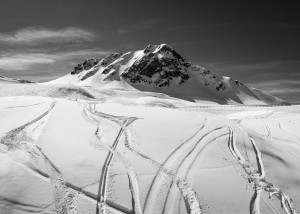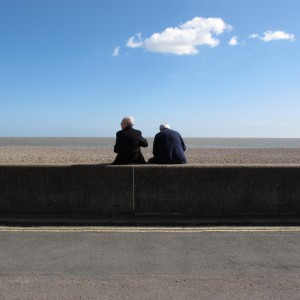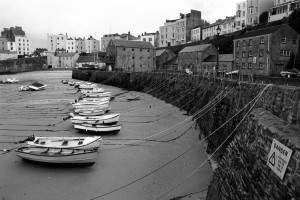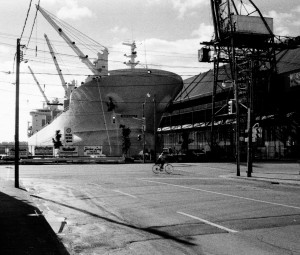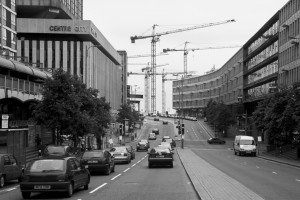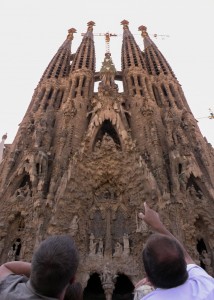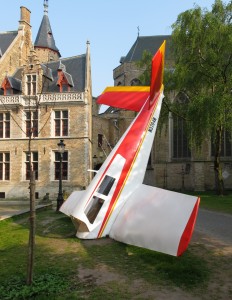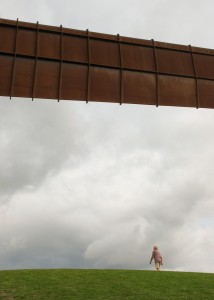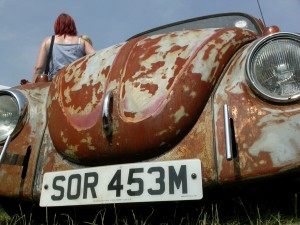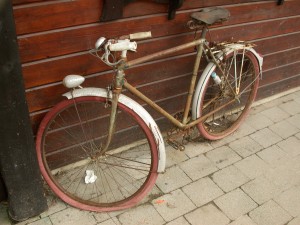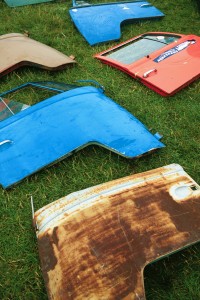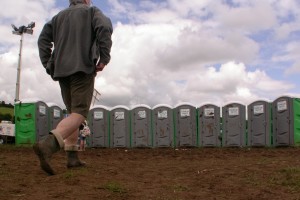Off the Beaten Track
The connection is lines, ie the double yellow ones at the coast and the ski and snowboard trails on this off-piste section of mountain in La Plagne, France.
Skiing off-piste, that is to say, off the specified runs or “off the beaten track” is not normally allowed or as easy to insure, which is why there are few ski and snowboard tracks in the image above. Although the snow can be more rewarding for skiers, the dangers of finding holes in the snow or not being found after a bad fall are real.
Perhaps taking such chances in such unknown conditions, as depicted by this image, is a visual representation of life. I just like the fairly random lines scored across the snow! I was on a chair lift, came across this scene and took out my camera to photograph it whilst holding ski poles and hoping I would have enough time to put the camera away again before having to disembark, which has to be done whilst the chair is moving! Risky and not really insurable.
The next image will involve a safer environment. Talking of “environment”, there’s probably a debate to be had about wintersports and the great outdoors.
One eye on the past
The connection is “sea walls”, which I know is similar to “seaside walks” from a few connections ago, but I’m a bit limited for choice this week because my pc is at the computer hospital! I can only use what I’ve already uploaded to WordPress, a predicament which would be solved by fully subscribing to the concept of the “cloud”, ie storing images away from home/work. Yes, I admit it, I’ve uploaded some potential connection candidates in advance! This might be cheating, or at least limiting.
Talking of cloud, the position of the ones in the above image in relation to the people suggests to me something about the passage of time. “One eye on the past” is probably a more positive way to describe how the lady might be moving on with her life, but equally a negative description could be “missed the boat” or “if only” or “back in my day…”. The cloud could imply that change has happened with the present/the future being difficult or impossible to deal with……and the people above thought that they were just having a rest and a snack! They were in fact taking part in a photo-psychological experiment on how to portray life-events based on the arrangement of physical items framed by an equilateral shape. (Sorry.)
I’m not sure what the fairly featureless, and apparently endlessly continuous, road, yellow lines, wall, beach, sea and sky of the photo say about the idea of how life goes on. Perhaps there’s a lot of “same-ness” and then now and again something interesting comes along, in this case a group of clouds. I suppose this means that we’d better not miss whatever the interesting thing is and fully appreciate it at the time. Looking back would then be possible to do with fondness etc, rather than sadness about missing the boat at the time.
Crikey, that was a somewhat deeper than expected set of words for the latest connection. I never know where these things are going until I start writing!
Carbon Dating
The connection is sea-going vessels moored in a harbour. This scene in Tenby might however be considered as being more photogenic than the previous photo from Toronto. I think it might have a similar vintage (early noughties) although it’s sometimes difficult to date black and white photos because they can “hide” age-revealing colourful elements. Also, it was originated on film so I don’t have any “metadata” to rely on (and my filing system is rubbish). If I had no idea at all of the capture date, I suppose the motor-boat and “Danger” sign would suggest it was taken in the last 30 or 40 years!
There’s not much to say about this image. It works in monochrome because of the white boats contrasting against the beach etc. Presumably the receding water in the harbour must’ve been very calm to enable the boats to sit on the beach in a perfect arc that reflects that of the sea wall. This is also due to the length of mooring rope for each boat. Is there a by-law stating a minimum or maximum length of rope for mooring?
Why “Carbon Dating”? Well, as I said above, I don’t know exactly when the photo was taken, but there’s a sort of double meaning to the phrase that crossed my mind . It would be interesting to know how much of a rise in the general sea-level, due to climate change caused by carbon dioxide emissions, would prevent the boats from being able to rest on this beach. Also, according to climate change theory, how soon could this happen?
There, I’ve managed to do my usual thing with this photo connection series and attach a controversial element to an otherwise, er, pleasant and innocent scene.
As for the next connection, there’s a choice between sea defences, beach, danger signs, monochrome, rope…..er?
(Oh by the way, it’s happened again, as with some earlier connection photos from Bruges, Birmingham and Barcelona the placename starts with the same letter! This was unintentional.)
Watching and Waiting?
The connection is “signalised junctions”. Although the one above from the quayside in Toronto (Queens Quay East/Lower Jarvis Street in October 2002) is a three-arm junction, the ship seems poised to pass through the junction from a virtual fourth-arm. It also seems to be watching the cyclist!
Although there’s an obvious difference between the size of the ship and bike, the image also shows the amount of space that’s been provided for highway use and yet there’s only a bike using it. The width of the road is based on the amount of space “needed” for peak-time traffic, which for long periods of the day is largely redundant. You could argue that such road space is also redundant during peak-times, because car drivers often take three empty seats with them. Urban transportation systems based on bicycles are far more efficient and much less space-hungry.
The image also shows the distances that pedestrians have to cross, which must be intimidating if there are cars and lorries using the junction. Having said that, “jaywalking” laws in Canada stop people from crossing roads when the “walk” signals aren’t shown, which means that crossing should be safe. The by-product of such limited crossing opportunities is community severance, reducing pedestrian interactions between each side of the street.
Jaywalking laws have been in force for decades in Canada and the USA and originate from the early days of motoring when the death toll due to collisions between people and cars was horrendous. The laws were invented by the car industry in order to shift the blame for vehicle collisions onto victims, at the same time claiming the streets for cars and effectively changing the traditional use of streets as places for people. The car was seen as an unwelcome guest in the street and some localities erected war memorial type monuments to commemorate child pedestrian traffic deaths. Perhaps this idea should be revisited for modern use instead of the temporary floral tributes that are all too commonly seen. Could it improve driving?
Sorry, I’ve managed to go from a simple walkabout with a camera in a non-touristy part of Toronto, which at the time I thought would be interesting, to a small rant about the state of “modern” transport infrastructure. There, I’ve done it again, I just wouldn’t let it lie, I’ve placed quotes around the word modern to suggest some dissatisfaction etc………….
Next Please!
The connection is tower cranes, in this case a multitude of them in a photo taken in June 2001 during the construction of the new Bull Ring shopping centre in Birmingham. (In common with the previous two posts, this photo is also brought to you by the letter B!) By the way, yes I was daft enough to stand in the road so I could get the composition right.
Although originated on colour slide, it has occurred to me that we are more used to seeing such record shots of cityscapes in black and white. Perhaps though it’s photos of the 1960s and 1970s that have up until recently been more popular because they come from an era just before many of the changes that occurred in built-up areas around that time. Town and city centres have however been changing again, from being car dominated with brutalist concrete buildings to being more pedestrian friendly with such concrete structures being replaced. Perhaps then there are many colour photos documenting the 1980s, 1990s and 2000s that can show significant differences between now and then.
This would hopefully be the case for central Birmingham (I’ve taken a few photos), which has seen many changes in the last 25 years or so. In fact the signalised junction used to have a horrible pedestrian underpass and the road level was much higher between the buildings. It probably looked quite futuristic in the 1960s and 1970s, being the epitome of a car orientated city of the future that has thankfully been relinquished in favour of a wider choice of more efficient transport modes and creating a city with a more humane environment. Similar things have happened on other parts of Birmingham’s inner ring road, which isn’t even a complete “ring” anymore. Hurrah!
The photo above actually documents a stage on the way to significant changes, ie the process of creating a building with the tower cranes, so it’s appropriate that the traffic signals on the junction are showing an amber signal. This might be lost in a black and white photo, but convention’s sake, here’s the black and white version below!
As a postscript to this scene, the building that’s been created is fairly iconic in one sense, due to the Selfridges part of it, and controversial in another because the development has reduced the popularity of retail in other parts of the city. Next idea please!
Slow Progress? (By whose standards?)
The connection is religious buildings. The aircraft was behind the Church of Our Lady in Bruges and the people here are observing progress at the Sagrada Familia in Barcelona. I guess the connection was also brought to you by the letter “B”, but I don’t allow such connections for this series!
The Sagrada Familia is probably famous for its apparently very lengthy construction period, having started in the late 19th century and expected to be complete in the first third of the 21st century, and of course for the very distinctive architecture by Gaudi. The lengthy construction period fascinates people, but this isn’t a new thing. For one thing, the Church of Our Lady was built mostly in the 13th, 14th and 15th centuries and cathedrals often took centuries to complete. Is there a feeling or expectation that in the modern era the construction of buildings, including religious buildings, should be quick or at least quicker than in the past? Having seen the detail involved in Gaudi’s building I think it’s understandable that things are taking a while. (By whose standards?)
As for the people in the photo, have they noticed something different from their last visit or is there something in the very busy facade that interests them? Perhaps they’re commenting on the tower crane’s crucifix-like form in what could be an appropriate position between two of the four towers. Sadly, the inability for me and the two chaps in the photo to communicate effectively in anything but our different native tongues meant that I never found out.
Another Piece of Winged Public Art
Yes, the connection is wings. I was going to say “in a more normal context” but it’s not often that you come across a very publically accessible plane-crash site (thankfully).
This scene was spotted in Bruges in 2012 and was part of the Kamarama art project. It was quite late in the day when I arrived to stay there for a few days, so there are no people looking at the apparently crashed aeroplane. The signs of close examination by interested people can however be seen in the image above, judging by the worn out grassy area around the wings. I’m not sure what could be further understood from closer inspection of the object, but I guess there’s a natural fascination with such unusual objects which means people are drawn towards them. The question I sometimes ask however after being able to get close to such things is along the lines of, “What now?”, or even, “So what?”/”Is that it?”
I believe the artist had a slightly different motive for creating the installation. The blurb associated with it states, “Yves Obyn created a very special art work for Kamarama. It represents a crashed Beechcraft Bonanza. A fanatic built his own airplane but because of the poor construction, it quickly crashed. The spectator is a disaster tourist, causing a congestion in the heart of Bruges due to the curiosity factor.”
The last sentence suggests the artist was more interested in the reaction of people to the installation, or indeed how many people might be interested in seeing it and/or moving closer to it (and causing congestion in the street). I think a “disaster tourist” might be one who is fascinated by disasters as well one who causes congestion. A similar situation might be the slow moving queue of vehicles on a motorway that often occurs when passing an incident on the opposite carriageway. There is no reason to slow down but fascination takes over.
I just took the photo as a record shot really, a holiday snap, and then I wondered what people thought about it and why they apparently wanted to get so close to it. It’s quite refreshing to learn that the artist seemed to just want to provoke mass interest and then perhaps see how people reacted to it. It is indeed a striking sight, a broken modern object surrounded by nice old buildings, but for me it did really fall into the “So what?” category. Perhaps I needed to see it with people around it.
One reason why it’s being shown here is that I have very few photos of winged objects, the only credible connection I could think of making with the last photo! Luckily I was able to make something out it that says something about human nature. One day however I might just keep the blogging aspect of this very simple and say, “There was green in the last photo and there’s green in this one.”
When Rust is Good
The connection is rust, in this case the type that is regarded as acceptable rather than the more common terminal tin-worm that must be stopped in its tracks at all costs.
Some people might recognise the rusty metal image above as being part of Antony Gormley’s Angel of the North sculpture. I say sculpture, but of course it was “engineered” by consultant engineers Arup (a former employer of mine) so that the massive structure would stand up. Although I started with trying to make an abstract image of the Angel rather than the more usual tendency to “get the whole thing into the picture”, an opportunity to put across an idea of scale and people’s amazement with the sculpture presented itself when the chap in the photo entered the frame. (This happens to me a lot….especially when using a digital camera with shutter-lag! Decisive Moment? Pah!) He wandered around quite a bit, looking up at the Angel and trying to get a good angle to take a photo. Then the rest of his group arrived, so he must’ve been so excited to see the Angel that he made his way from the nearby car park far quicker than the others. I did something similar.
People might assume that the rusty surface is a bad thing and therefore that the Angel only has a limited life-span. It is however constructed from weathering steel which protects itself from corrosion with a thin layer of “rust” that develops on the surface. There are many examples where this material has been used in the construction industry. Antony Gormley also uses the material in much of his public art, eg Another Place at Crosby Beach, The Iron Man in Birmingham. The “rust” used in these applications is therefore a good thing as it can look attractive, plus it provides some of the meaning behind the work, ie the Angel and Iron Man represent areas founded on a heavy industrial past.
The two images below show where the traditional tin-worm version of rust is used in a sort of positive way. Rat look cars are popular on the custom car scene, with the rust being created and then further corrosion halted. The rusty bike is, crucially, an old-style bike that was helping to show that the business it was standing outside of had been trading there for a long time, and that the owners presumably adopt traditional business values such as fairness and good service.
Yet More Doors in a Field
The loos in the field had doors, so here are some more doors in a field.
Making the connection this time was difficult because once I’d decided on the idea of “doors” I realised I had very few photos of them! (I have lots of windows photos though. I wonder why that is?) Anyway, one reason behind the connections project is to help me to improve my knowledge of my back-catalogue.
A field is not normally where you’d expect to find a clutch of VW camper van doors. A wider view than the abstract approach adopted here would’ve revealed more about the context, but it might be fairly obvious to most people that the doors are being offered for sale to those wishing to complete their camper van restoration projects. Such “auto-jumbles” can be found at classic car/vehicle events…and what a heap of old tat it can seem to be!
Being a classic car owner (mk2 Golf) I often wonder why people bother to keep them going, or even start a restoration project based on a rusting hulk more deserving of a one-way trip to a scrap yard. I also wonder about the basis on which certain vehicles are awarded classic status. Here’s a list of possible reasons (not exhaustive):
– Many people wanted one at the time of manufacture
– First of a kind
– They were held in high regard because of some performance capability
– Representative of a particular period in time
– Look pretty
– Carry some interesting provenance
– Have “fun” driving characteristics (“Fun” of course being the subject of another debate, given that public roads are not race tracks.)
Many of the cars people attach classic status to are in fact just “old cars”. Sure they can be cheap to run with low/no VED tax, low insurance and an easy maintenance regime, but they can fail on the need for driver/passenger safety, fuel economy and reduced emissions. Why should such cars be allowed on the road if they substantially fail on these aspects? (Such failures were a good reason for the recent scrappage scheme, but then building replacement cars arguably wastes energy.)
This brings me back to the doors in the photo. Old style VW camper vans might look nice (ish), evoke a sense of freedom largely associated with the 1960s and are fairly practical in terms of internal space use, but apart from this there’s nothing to recommend them: they rust to pieces, are challenging to drive in a straight line, are underpowered, emit foul exhaust fumes and rely on the driver to act as the front crumple zone in a crash. On the latter point however, perhaps all cars should place the driver right at the front of the vehicle with just a thin sheet of steel for protection because it might dissuade drivers from tail-gating other vehicles at high speed and generally driving too fast. Does anyone want to buy a mk2 Golf?
The Festival Season
The connection is “temporary toilets”. Here are some in a more familiar setting.
It’s the festival season and the success of such events can be determined purely by how good or bad the toilet facilities were. This image comes from a folk music festival in 2007 that effectively ran from arriving on Thursday to leaving on Monday morning, so it was critical that the loos should provide a decent service throughout the whole period. Needless to say they didn’t but at least the heat wasn’t so stifling that being inside one the plastic boxes was unbearable. Instead we just had wet weather and therefore mud, which are the other determinants of festival success/distress! The loo facilities at the festival were basic, with nothing provided for hand-washing, so it’s a wonder that with all the fast-finger-food on offer there wasn’t an epidemic of stomach upsets. I gather this particular festival has better facilities these days.
I shouldn’t dwell too much on the loo situation because up until a few years ago it was accepted that there would be a few such hardships to endure at a music festival. At least the music would be enjoyable and you could strike-up memorable conversations with strangers. Also, at least the plastic box loos do provide some comfort if emptied before reaching the brim and toilet paper replenished in a timely manner. The situation a generation before the year of this festival might’ve been entirely different, but the attraction of the music would’ve ensured that any thoughts of loo quality would not matter. The music is usually the main reason for going (that’s nearly a pun).
As for festivals in general, do bands perform better outside? Do audiences enjoy the music more than at an indoor venue?

